Archive
Open Studio Evenings by Käthe and Walter Langhammer
Open Studio Evenings by Käthe and Walter Langhammer
Word Count: 9
- Open Studio Evenings by Käthe and Walter Langhammer
- Salon
- 1940
- 1957
The painter Walter Langhammer and his wife Käthe built an informal infrastructure to promote local avant-garde artists and regularly invited them to Open Studio Evenings at their studio.
Word Count: 29
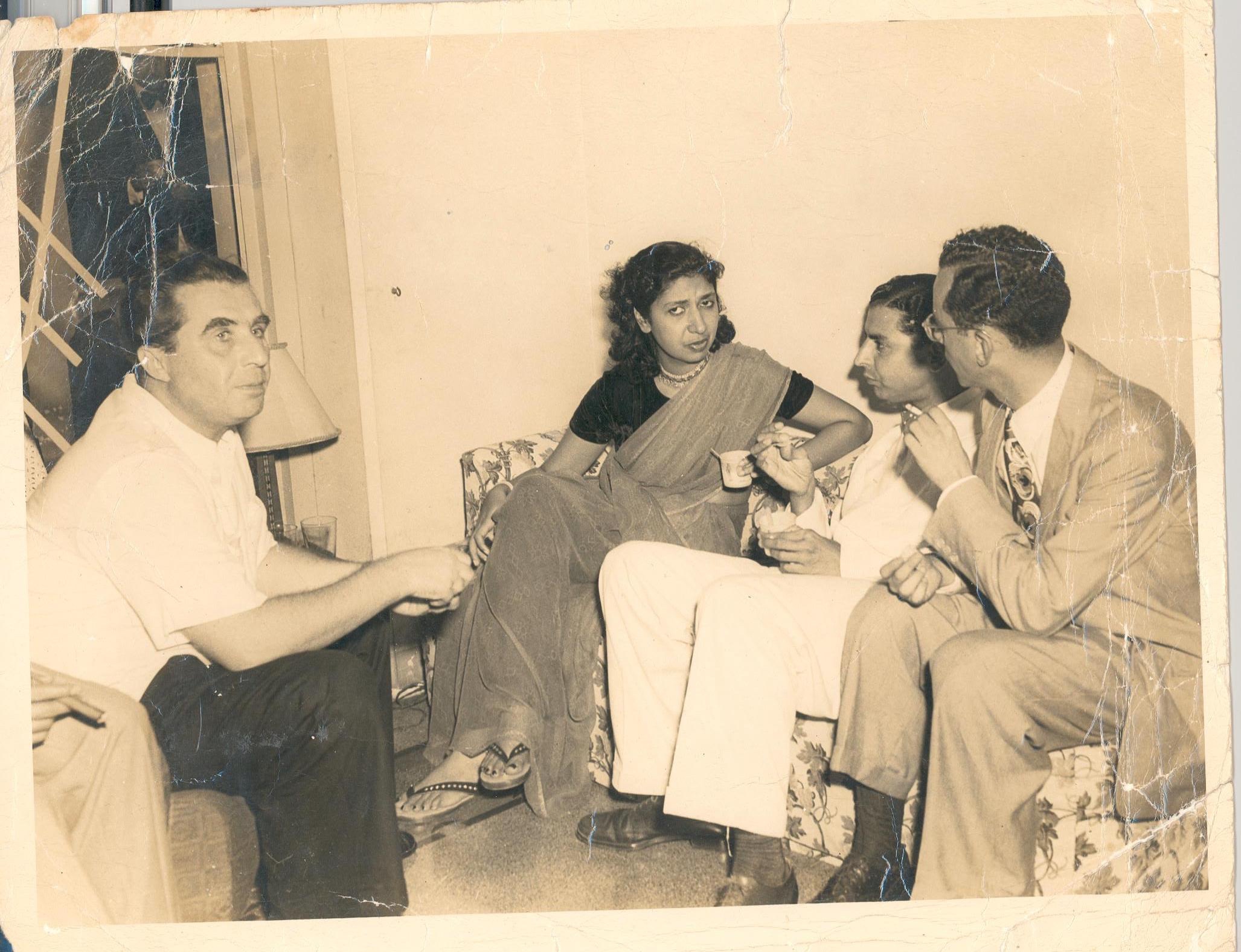
Open evening at the Langhammer’s, from left: Walter Langhammer, unknown woman, Kekoo Gandhy, Wayne Hartwell (American cultural affairs diplomat) n.d. (© Digital Photo Archive Margit Franz; authorised by the late Kekoo Gandhy; All Rights Reserved). 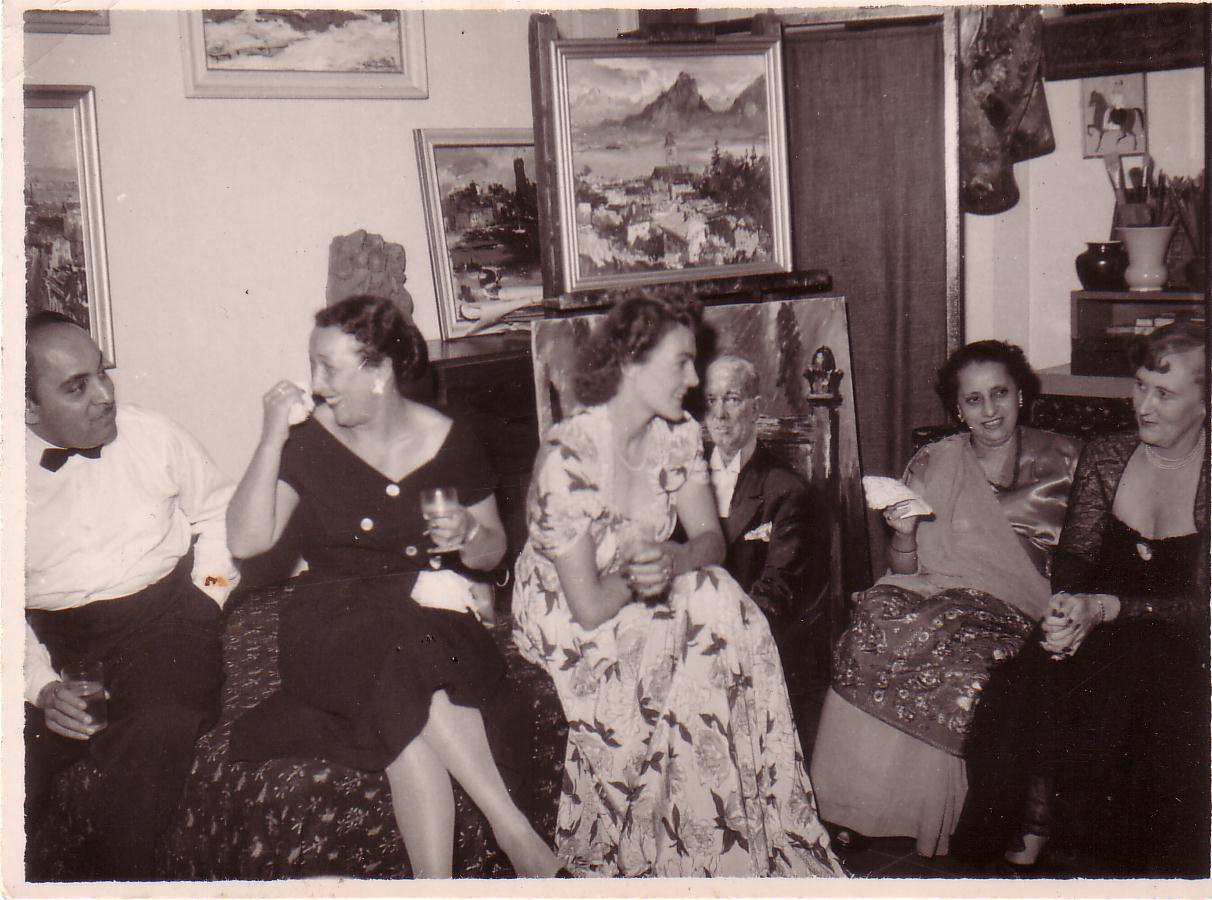
Dinner party at the Langhammer’s studio amidst his paintings (© Digital Photo Archive Margit Franz; authorised by the late Kekoo Gandhy; All Rights Reserved). 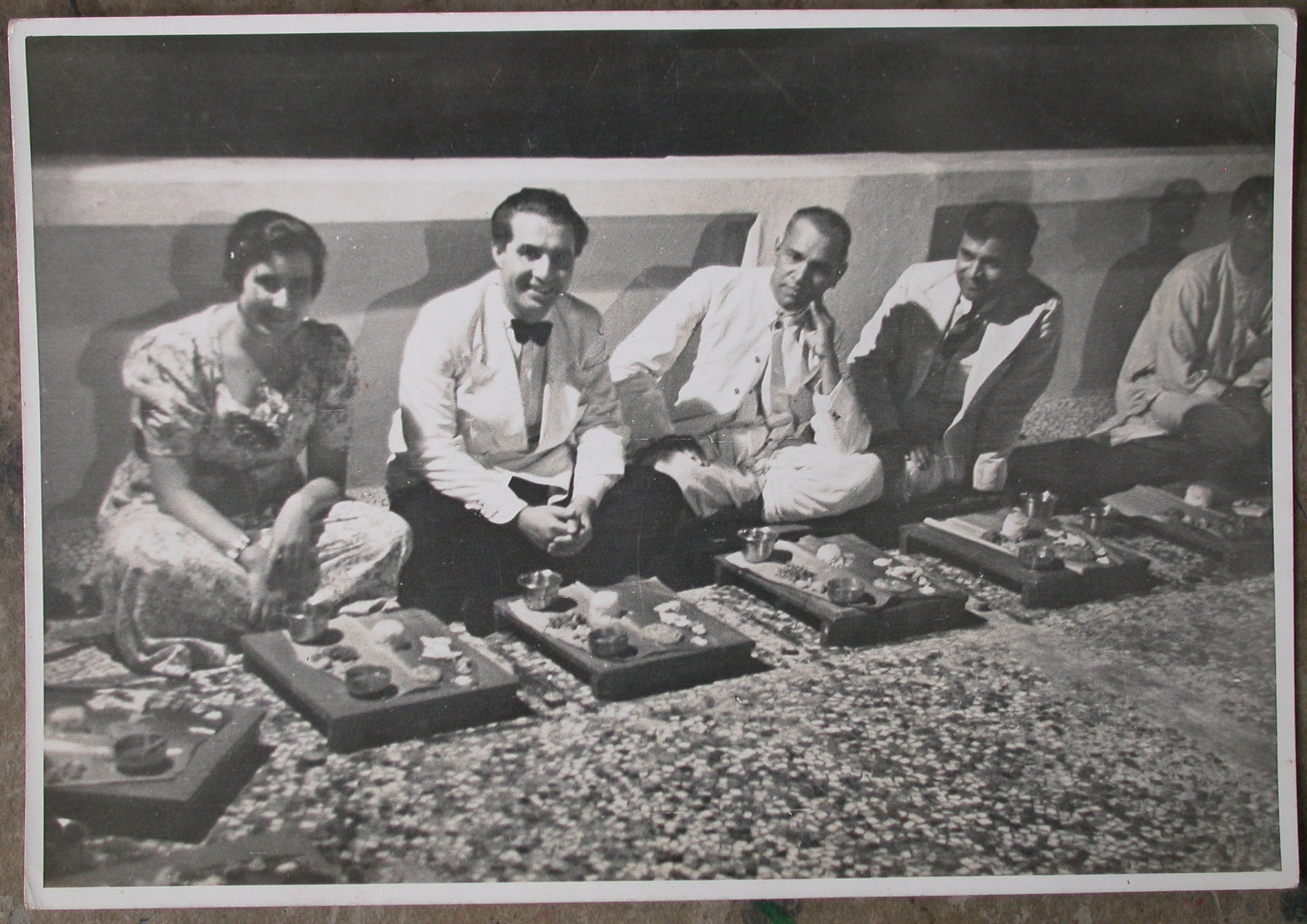
Käthe and Walter Langhammer (far left) attending an Indian dinner, late 1930s/early 1940s (© Digital Photo Archive Margit Franz; authorised by the late Kekoo Gandhy; All Rights Reserved). 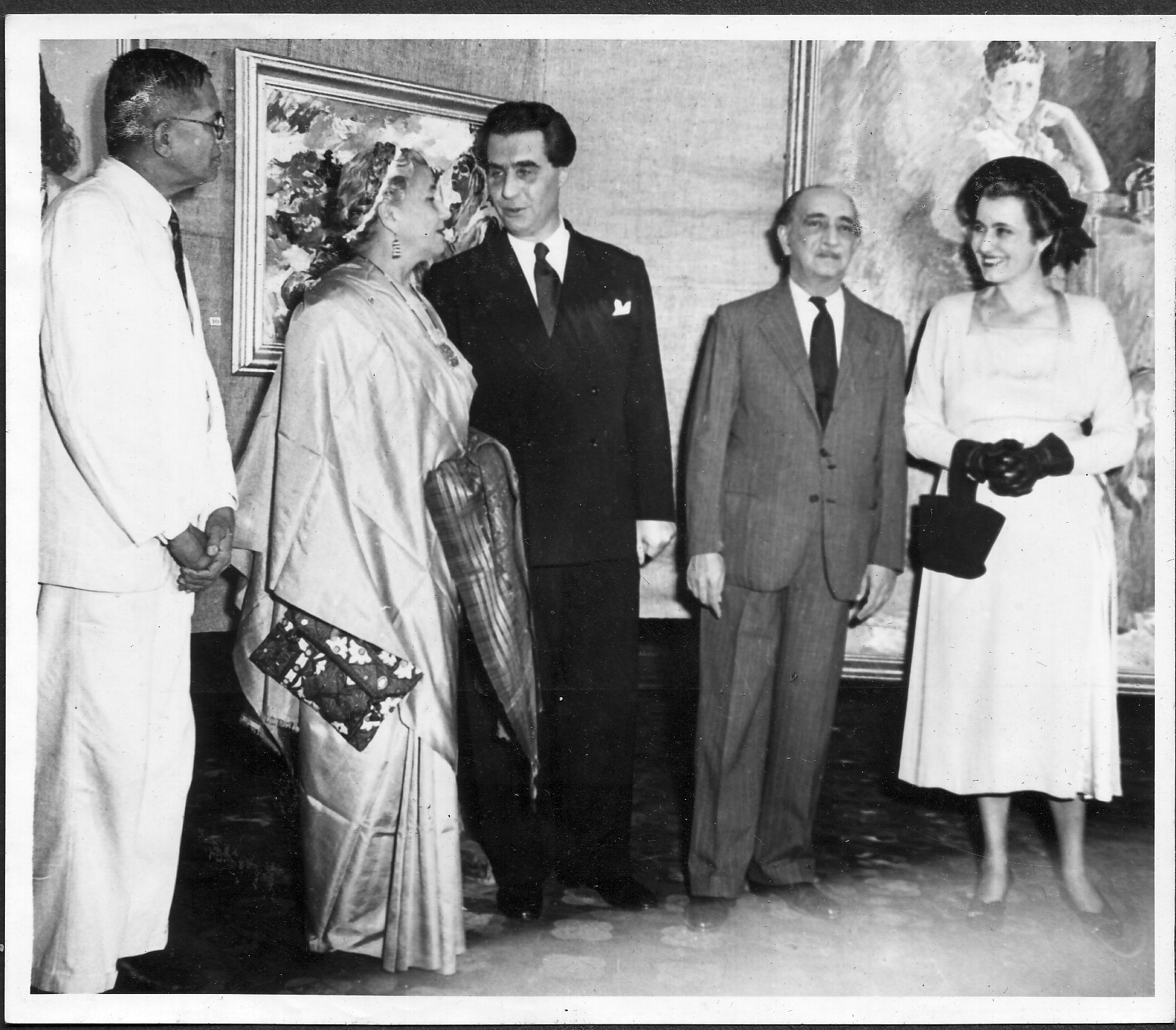
Opening of the annual Langhammer exhibition by Sir Cowasjee Jehangir in the Convocation Hall, 27 November 1949 (from left: Mr. C.V. Oak, Rani Maharaj Singh, Walter Langhammer, Sir Cowasjee Jehangir, Käthe Langhammer) (© Digital Photo Archive Margit Franz; authorised by the late Kekoo Gandhy; All Rights Reserved). 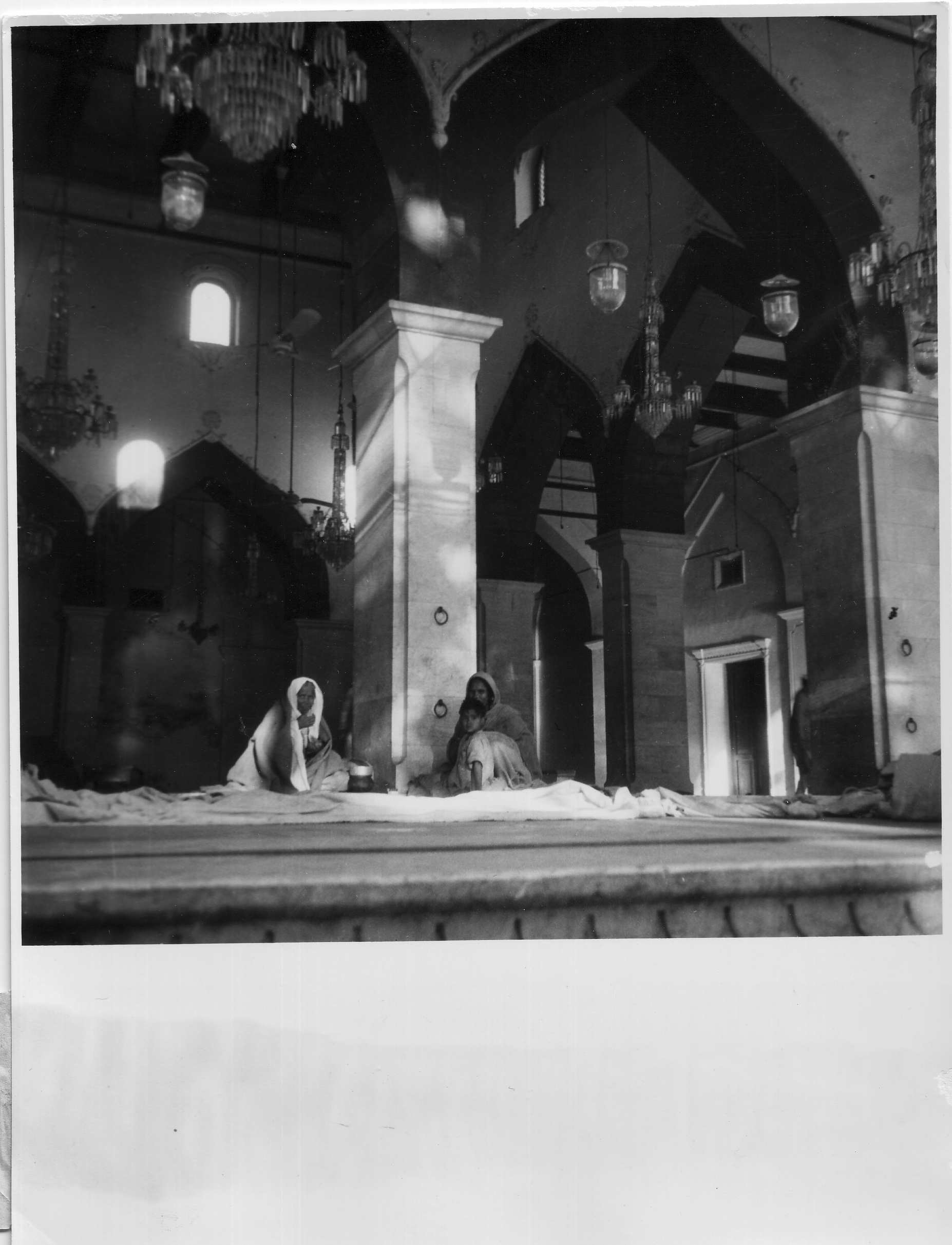
Photography Morning in the Great Mosque in Ajmer (translation by the author) by Käthe Langhammer, Rajasthan, 1940s (© Archive Margit Franz: Langhammer Photo Archive; All Rights Reserved). 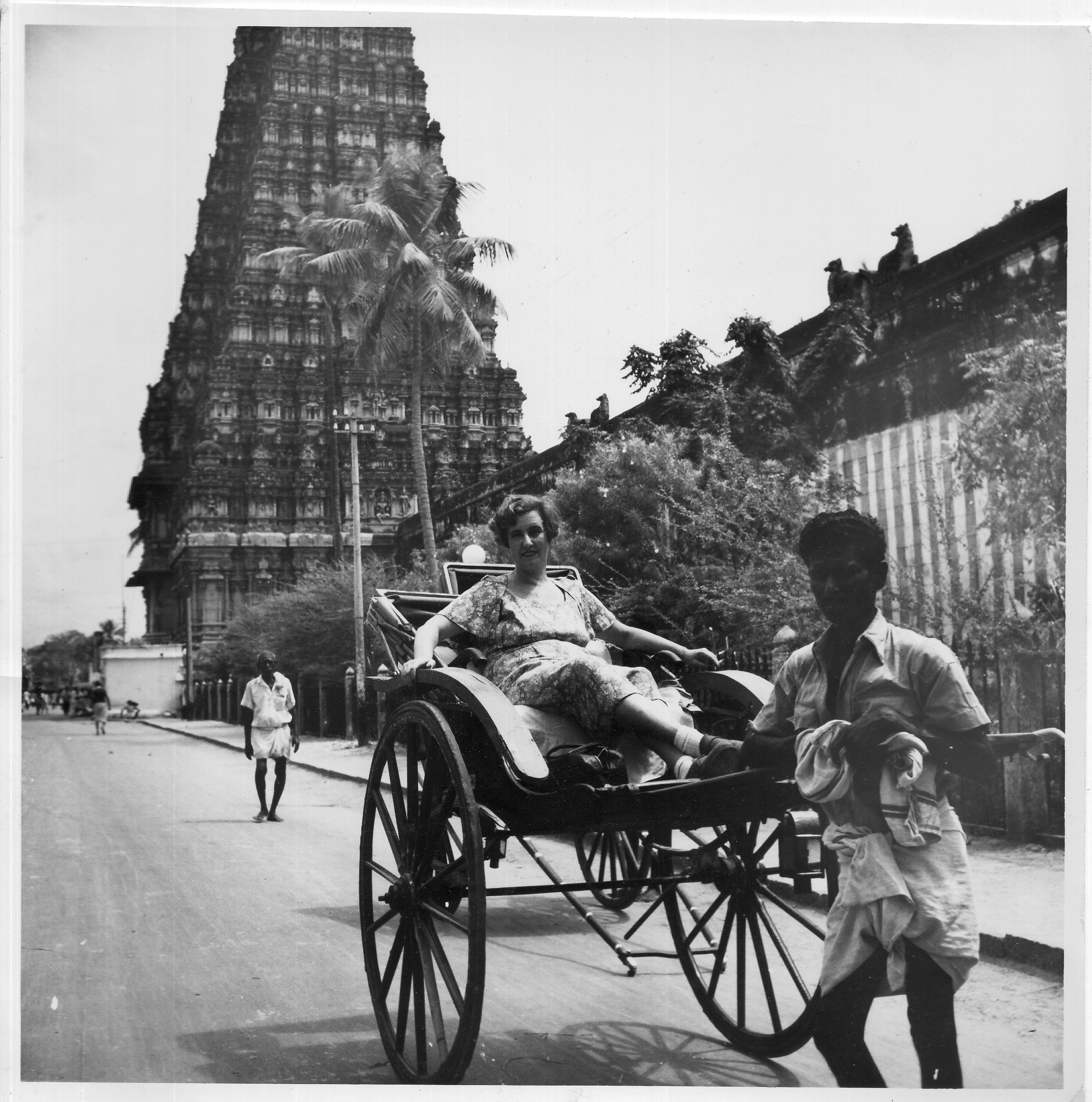
Käthe Langhammer in South India. They toured all of India for The Times of India Annual. Photo by Walter Langhammer (© Archive Margit Franz: Langhammer Photo Archive; All Rights Reserved). 
Invitation card for the Langhammers’ farewell party, April 1957 (© Digital Photo Archive Margit Franz; authorised by the late Kekoo Gandhy; All Rights Reserved). 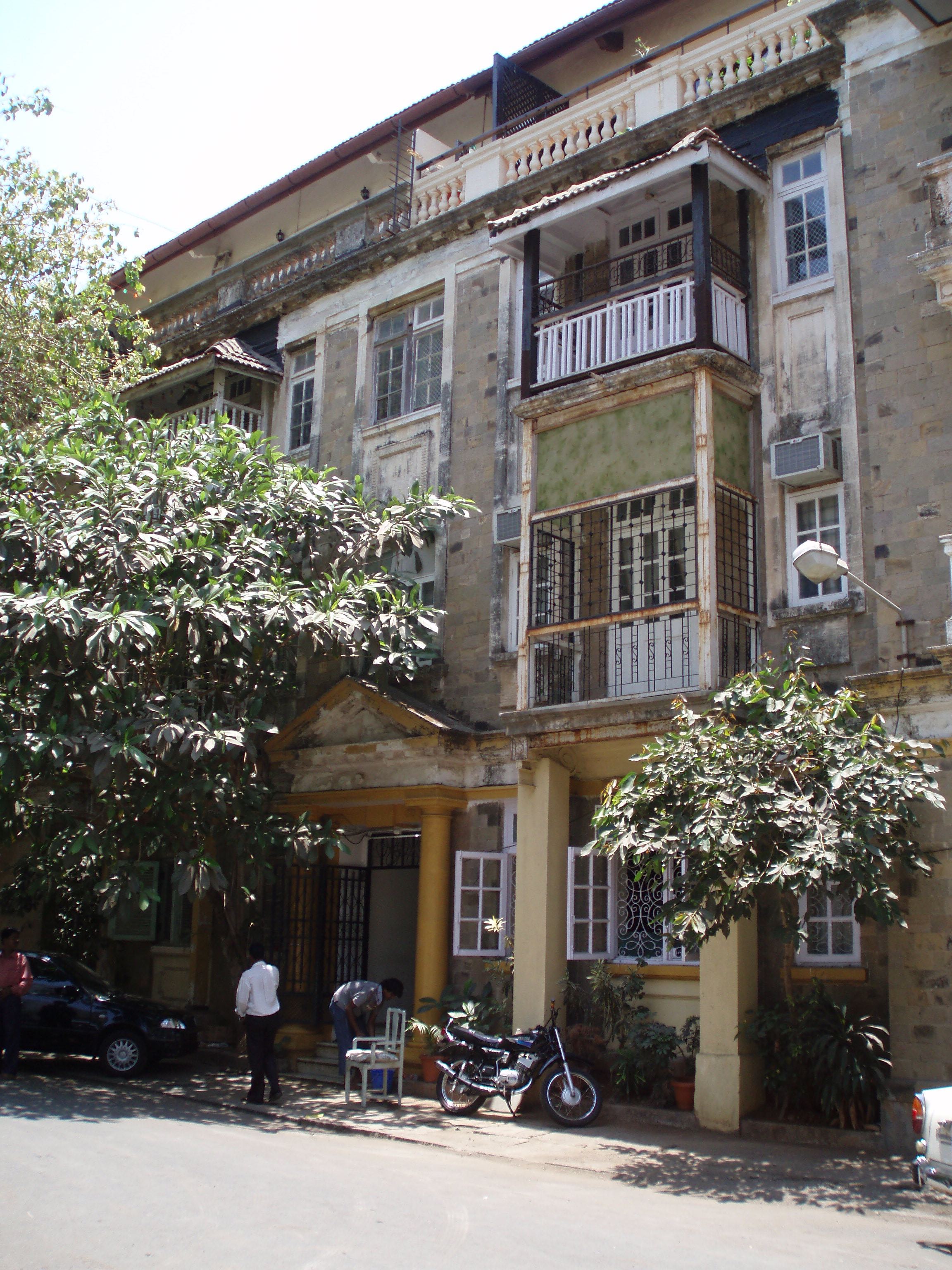
Entrance to Langhammer’s residence at 20 Nepean Sea Road (Photo: Margit Franz, 2007; All Rights Reserved). Ariel. “Men, Matters and Memories.” The Times of India, 28 April 1957, p. 8.
Dalmia, Yashodhara. The Making of Modern Indian Art: The Progressives. Oxford University Press, 2001.
Franz, Margit. “Transnationale & transkulturelle Ansätze in der Exilforschung am Beispiel der Erforschung einer kunstpolitischen Biographie von Walter Langhammer.” Mapping Contemporary History. Zeitgeschichten im Diskurs, edited by Margit Franz et al., Böhlau, 2008, pp. 243–272. Academia, www.academia.edu/45523873/Transnationale_und_transkulturelle_Ans%C3%A4tze_in_der_Exilforschung_am_Beispiel_der_Erforschung_einer_kunstpolitischen_Biographie_von_Walter_Langhammer. Accessed 14 March 2021.
Franz, Margit. “Graz – Wien – Bombay – London: Walter Langhammer, Künstler und Kunstförderer.” Historisches Jahrbuch der Stadt Graz, vol. 40, edited by F. Bouvier, and N. Reisinger, Stadt Graz – Kulturamt, 2010, pp. 253–276. Academia, www.academia.edu/45524011/Graz_Wien_Bombay_London_Walter_Langhammer_Künstler_und_Kunstförderer. Accessed 14 March 2021.
Franz, Margit. “Exile meets Avantgarde: ExilantInnen-Kunstnetzwerke in Bombay.” Going East – Going South. Österreichisches Exil in Asien und Afrika, edited by Margit Franz and Heimo Halbrainer, CLIO, 2014, pp. 403–431. Academia, www.academia.edu/49079321/Exile_meets_Avantgarde_ExilantInnen_Kunstnetzwerke_in_Bombay. Accessed 16 June 2021.
Franz, Margit. Gateway India: Deutschsprachiges Exil in Indien zwischen britischer Kolonialherrschaft, Maharadschas und Gandhi (1st ed.). CLIO, 2015.
Franz, Margit. “From Dinner Parties to Galleries: The Langhammer-Leyden-Schlesinger Circle in Bombay – 1940s through the 1950s.” Arrival Cities. Migrating Artists and New Metropolitan Topographies in the 20th Century, edited by Burcu Dogramaci et al., Leuven University Press, 2020, pp. 73–90. Project Muse, doi: 10.1353/book.77990. Accessed 30 March 2021.
Franz, Margit. “Die multiplen Identitäten und Loyalitäten der Käthe Langhammer.” Das Exil von Frauen. Historische Perspektive und Gegenwart (biografiA. Neue Ergebnisse der Frauenbiografieforschung, 26), edited by Ilse Korotin and Ursula Stern, Praesens Verlag, 2020, pp. 148–167.
Gandhy, Kekoo, “The Beginnings of the Art Movement.” City of Dreams, special issue of, Seminar, no. 539, August 2003, www.india-seminar.com/2003/528/528%20kekoo%20gandhy.htm. Accessed 21 February 2021.
Tata Institute of Fundamental Research. “K.H. Ara and the TIFR Art Collection: One fragment of the story of the Institute’s Art Collection with a focus on one of the founder members of the Progressive Artists’ Group – Krishnaji Howlaji Ara.” Google Arts & Culture, artsandculture.google.com/exhibit/k-h-ara-and-the-tifr-art-collection-tata-institute-of-fundamental-research/_AJyoAcQsJnlKA?hl=en. Accessed 15 April 2021.
Word Count: 349
Private Archive Margit Franz, Sinabelkirchen:
Audio file: Kekoo Gandhy in conversation with Khorshed Gandhy, Rashna Imhasly-Gandhy and son of Roger van Damme. Mumbai, n.d. (kindly provided by Rashna Imhasly-Gandhy; private archive Margit Franz: digital audio material and transcript by Margit Franz);
Archival records from personal interviews between the author and Khorshed and Kekoo Gandhy, Mumbai, 30 April to 3 May 2003; 18 to 22 January 2004; 26 April to 12 May 2007; 13 to 15 October 2008; 24 October 2010;
Archival records from a personal interview between Yashodhara Dalmia and Maseeh Rahman and Käthe Langhammer, London, August 1993 (kindly provided by Yashodhara Dalmia; private archive Margit Franz: digital audio material and transcript by Margit Franz);
Archival records from personal interviews between the author and S.H. Raza, Paris, 3 to 4 July 2006; and Gorbio, 18 August 2010.Private Archive of late Khorshed & Kekoo Gandhy, Mumbai.
Bombay Art Society exhibition catalogues from 1938 till 1960.
Times of India Archive via Staatsbibliothek zu Berlin:
http://erf.sbb.spk-berlin.de/historical-newspapers/. Accessed 18 April 2021.Walter Langhammer, The Critic, 1943, (© TIFR; Mumbai, https://artsandculture.google.com/asset/the-critic/5gFGyDDACwG86w).
Word Count: 166
20, Nepean Sea Road, Bombay (now 20, Nepeansea Rd, Cumballa Hill, Mumbai) (studio, 1940/41–1957).
- Bombay
- Margit Franz. "Open Studio Evenings by Käthe and Walter Langhammer." METROMOD Archive, 2021, https://archive.metromod.net/viewer.p/69/2951/object/5141-11941985, last modified: 14-09-2021.
-
Mulk Raj AnandWriterPhilosopherArt PatronCultural CriticBombay
As a global socialist and modernist, Mulk Raj Anand sought and shaped opportunities for intellectual exchanges between Asia and Europe.
Word Count: 20
Kekoo Minochair GandhyFrame Shop OwnerGalleristArt CollectorBombayStarting from a cosmopolitan milieu for young local artists, Kekoo and his wife Khorshed Gandhy developed a business model that turned the frame shop into Gallery Chemould.
Word Count: 27
Rudolf von LeydenGeologistAdvertisement SpecialistJournalistArt CriticArt CollectorCartoonistBombayThe advertisement expert, Rudolf von Leyden, became a major art critic and art historian in Bombay in the 1940s, advocating an urgent need for modernism in art in post-colonial India.
Word Count: 30
Emanuel SchlesingerFactory OwnerTechnical DirectorArt CollectorArt CriticBombayThe art collector Schlesinger provided primarily financial aid by creating working opportunities for young artists in post-independence Bombay, and initiated the corporate culture of buying art.
Word Count: 26
Iconic Photo of the Progressive Artists’ Group and Their AssociatesPhotographBombayThere are two versions of the PAG photo at the opening of M.F. Husain's first solo exhibition in 1950 (published in 1996 and 2003) and two narratives about the opening.
Word Count: 28
Schimmel’s Wedding Film 1948FilmBombayThe film shows Schimmel’s Jewish wedding ceremony at the prestigious Glamis Villa, followed by lunch at the Taj Mahal Hotel. Among the guests were Käthe and Walter Langhammer.
Word Count: 30
Picture of Rudi von Leyden’ s Bust by Sadanand K. BakrePhotographBombayThe picture of the previously lost and recently located sculpture by Sadanand K. Bakre reflects the relationship between the artist Bakre and the art critic Rudi von Leyden.
Word Count: 28
One Man exhibition and subsequent trial, Akbar PadamseeCourt CaseBombayAkbar Padamsee’s solo exhibition in Bombay in 1954 was overshadowed by his arrest on charge of displaying obscene pictures. The subsequent court case drew support from across the art world.
Word Count: 30
The Feldberg Art Collection. A Series of Three Exhibitions of European Artworks collected by the Feldberg FamilyExhibitionBombayIn 1950 the Institute of Foreign Languages organised three exhibitions of paintings from the collection of the exiled Jewish manufacturer Siegbert Feldberg and his wife Hildegard from Stettin.
Word Count: 27
ChemouldGalleryFrame ShopBombayChemould’s history stretches from its beginnings as a manufacturer of chemical mouldings and frames in 1941 over to a hub for art circulation displaying a variety of artists in Bombay.
Word Count: 30
TIFRUniversity / Higher Education Institute / Research InstituteBombayThe TIFR is one of India’s premier scientific institutions. Inside its buildings, scientists ponder over path-breaking ideas. Also, within its hallowed walls is a fine collection of modern Indian art.
Word Count: 31
Institute of Foreign LanguagesLanguage SchoolExhibition SpaceLibraryTheatreBombayWith its wide range of cultural activities, the Institute of Foreign Languages − founded in 1946 by the Viennese emigrant Charles Petras − became a glocal contact zone in Bombay.
Word Count: 27
Air IndiaAirlineBombayAir India was one of the largest art collectors in Bombay. Indian art was used as branding for Air India in international competition right from the start.
Word Count: 27
Jehangir Art GalleryArt GalleryAuditorium HallLibraryBombayEfforts to create spaces for the democratic presentation, discussion and reflection of art in Bombay after independence led to the establishment of the Jehangir Art Gallery in 1952.
Word Count: 27
Breach Candy ClubClubBombayThe Breach Candy Club, restricted to “Europeans”, was a favourite spot for the exiled financial elite with its saltwater pool shaped like the map of British India and sea view.
Word Count: 30
Bombay Art SocietyAssociationBombayOne of the oldest art societies in India founded by colonial rulers, Bombay Art Society showcased art students and professional artists from all over India, including the Progressive Artists of Bombay.
Word Count: 31
Homi Jehangir BhabhaScientistCollectorArtistBombayHomi Jehangir Bhabha was a world class scientist, institution builder, an artist and art connoisseur. His vision for growth of science and art has had significant impact in post-colonial India.
Word Count: 30
The Leydens: Sculpture, Paintings, CartoonsExhibitionBombayIn 1948 Albrecht and Rudi von Leyden sold their personal works of art in order to set up an “Artists' Aid Fund”, which became an institution in the following years.
Word Count: 29